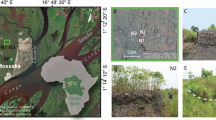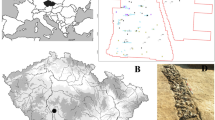Abstract
The prehistoric Lowland Maya supported an elaborate civilization, which reached peak population densities in the tropical forests of Guatemala, Belize and southern Mexico during the Classic period between AD 300 and 900. It has been proposed that the Maya turned to labour-intensive construction of raised planting platforms in wetlands for year-round cultivation. Excavations at San Antonio Rio Hondo, northern Belize1, provided the first archaeological data for this hypothesis. In our analysis of data from the San Antonio site, we conclude that the only indisputable evidence that prehistoric wetland cultivation occurred comes from a time before peak population of the Classic period, and that the technique required less labour than previously envisioned. Exploitation of swampy terrain initially involved dry-season cropping without extensive ditching and later ditching, probably for soil drainage.
This is a preview of subscription content, access via your institution
Access options
Subscribe to this journal
Receive 51 print issues and online access
$199.00 per year
only $3.90 per issue
Buy this article
- Purchase on Springer Link
- Instant access to full article PDF
Prices may be subject to local taxes which are calculated during checkout
Similar content being viewed by others
References
Puleston, D. E. in Social Process in Maya Prehistory (ed. Hammond, N.) 449–467 (Academic, New York, 1977).
Wright, A. C. S. et al. Land in British Honduras Colonial Research Publ. 24 (1959).
High, L. R. Jr in Carbonate Sediments, Clastic Sediments and Ecology (eds Wantland, K. W. & Pusey, III, W. C.) 53–96 (American Association of Petroleum Geologists, Tulsa, 1975).
Wilk, R. R. thesis, Univ. Arizona (1981).
Antoine, P. P., Skarie, R. L. & Bloom, P. R. in Maya Subsistence (ed. Flannery, K. V.) 227–236 (Academic, New York, 1982).
Author information
Authors and Affiliations
Rights and permissions
About this article
Cite this article
Bloom, P., Pohl, M., Buttleman, C. et al. Prehistoric Maya wetland agriculture and the alluvial soils near San Antonio Rio Hondo, Belize. Nature 301, 417–419 (1983). https://doi.org/10.1038/301417a0
Received:
Accepted:
Issue Date:
DOI: https://doi.org/10.1038/301417a0
This article is cited by
-
The center and the edge: Archaeology in Belize, 1809?1992
Journal of World Prehistory (1993)
-
Economic plant species associated with prehistoric agriculture in the Maya lowlands
Economic Botany (1984)
Comments
By submitting a comment you agree to abide by our Terms and Community Guidelines. If you find something abusive or that does not comply with our terms or guidelines please flag it as inappropriate.



